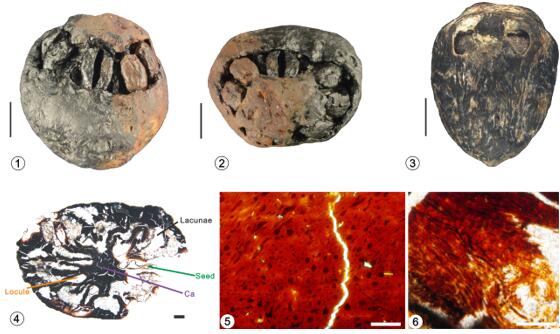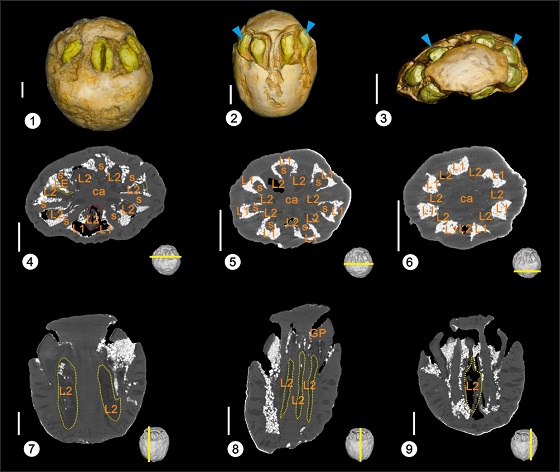Choerospondias axillaris, commonly known as the Nepali hog plum, belongs to the Asian endemic genus Choerospondias of the Anacardiaceae. The fruit of Choerospondias is formed by a thin epicarp, a fleshy, sweet edible mesocarp, and a woody endocarp. It is a common fruit for a variety of animals such as deer and hornbill in the rainforest. In South China, Choerospondias pulp is often made into soft candy, which is a popular local snack.
Commonly only the woody endocarps are preserved as fossils. Choerospondias fossil endocarps have been reported from a number of localities in Europe and Asia, ranging from the Eocene to the Holocene. Masses of Choerospondias endocarps have also been found in several archeological sites as early as ~ 8000 yr B.P. in southwestern and southeastern China, suggesting that Choerospondias was an important food plant for early humans in the region.
Recently, Drs. WANG Zixi, SHI Gongle, SHU Junwu, and YIN Suxin from the Nanjing Institute of Geology and Palaeontology, Chinese Academy of Science (NIGPAS), and other members from the Chicago Botanic Garden, USA, collaborated with a research focusing on numerous new materials of Choerospondias preserved as mummified fruit fossils from the Middle Miocene Fotan flora in Zhangpu, Fujian province, southeast China. The research results have been published in the Review of Palaeobotany and Palynology.
In this paper, a new species Choerospondias fujianensis sp. nov is described, which is characterized by having five or seven radially arranged germination pores at the subapical region of endocarp. Fossils indicate that Choerospondias was more diverse in the Miocene than today. According to the palaeogeographical history of Choerospondias, the genus was widely distributed in Eurasia during the Oligocene but disappeared in Europe after the Mid-Miocene Climatic Optimum (MMCO), but there is only one species of Choerospondias in East Asia today. The genus has a nearly continuous fossil record in East Asia since the Oligocene. Palaeoecologic analysis indicates that the relatively wide range of adaption of Choerospondias may play an essential role in its current survival in East Asia.
This research was jointly supported by the Strategic Priority Research Program (B) of the Chinese Academy of Sciences, the National Science Foundation of China, the Natural Science Foundation of Jiangsu Province, the State Key Laboratory of Palaeobiology and Stratigraphy, Nanjing Institute of Geology and Palaeontology, CAS.
Reference: Zixi Wang, Fabiany Herrera, Junwu Shu, Suxin Yin, Gongle Shi*, 2020. A new Choerospondias (Anacardiaceae) endocarp from the middle Miocene of Southeast China and its paleoecological implications. Review of Palaeobotany and Palynology, 283: 1–10. https://doi.org/10.1016/j.revpalbo.2020.104312.

The morphological structures (1-3) and anatomical details (4-6) of Choerospondias fujianensis sp. nov. endocarp from the middle Miocene of Fujian, Southeast China

The morphological structures (1-3) and internal structures (4-9) of Choerospondias fujianensis sp. nov. endocarp from the middle Miocene of Fujian, Southeast China
